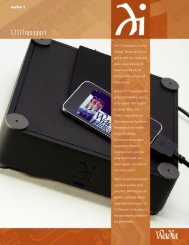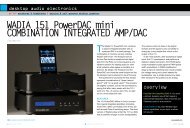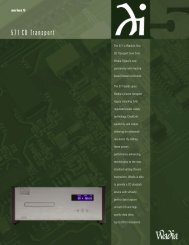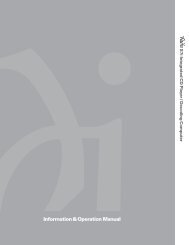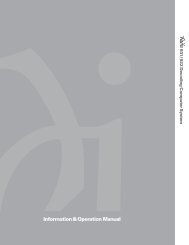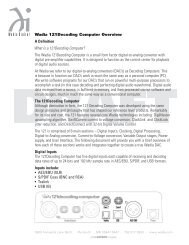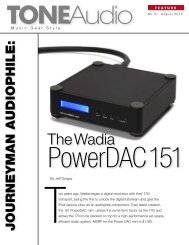You also want an ePaper? Increase the reach of your titles
YUMPU automatically turns print PDFs into web optimized ePapers that Google loves.
<strong>121</strong>_<strong>Manual</strong>_<strong>Print</strong>_03-12:Layout 1 3/30/12 9:41 AM Page 2<br />
Specifications:<br />
Decoding Software:<br />
Resampling Rate:<br />
Digital Inputs:<br />
Input Data Rates:<br />
Analog Outputs:<br />
Headphone Outputs:<br />
Headphone Sensitivity:<br />
Dimensions:<br />
Weight:<br />
Finish:<br />
DigiMaster<br />
1.4MHz<br />
AES/EBU (XLR), Coaxial (RCA and BNC),<br />
Toslink Optical, USB B<br />
44.1kHz, 48kHz, 88.2kHz, 96kHz, 176.4kHz,<br />
192kHz (up to 24 bits)<br />
One Pair Balanced (XLR),<br />
One Pair Unbalanced (RCA)<br />
Both outputs simultaneously active<br />
One 1/4” output<br />
Adjustable<br />
2.7 x 8 x 8 in., 6.68 x 20.32 x 20.32 cm<br />
2.5 lbs. (1.13 kg)<br />
Black Powder Coated Aluminum<br />
manual<br />
3900 Annapolis Lane North . Plymouth . MN 55447-5447 . 763.577.0593 . www.wadia.com<br />
W a d i a D i g i t a l W a d i a D i g i t a l<br />
<strong>121</strong>DecodingComputer
<strong>121</strong>_<strong>Manual</strong>_<strong>Print</strong>_03-12:Layout 1 3/30/12 9:41 AM Page 4<br />
Warranty<br />
This Warranty covers the <strong>Wadia</strong> <strong>121</strong>Decoding Computer. <strong>Wadia</strong> Digital warrants that this product<br />
shall be free from defects in materials and workmanship for: 1 year for all parts of the product<br />
(excluding batteries).<br />
The warranty period begins at the date of sale and is subject to the following requirements and<br />
understandings:<br />
1 This is a non transferable warranty.<br />
2 The product must not have been modified in any manner whatsoever, or the warranty is<br />
immediately voided.<br />
3 The product must not have been stored in a humid, damp environment; nor subjected to<br />
weather, water, or salt spray.<br />
4 During the warranty period <strong>Wadia</strong> will repair or replace at our discretion a defective <strong>Wadia</strong><br />
<strong>121</strong>Decoding Computer with a similar available product, at no cost to the owner for labor,<br />
materials, and shipping charges from <strong>Wadia</strong>.<br />
5 <strong>Wadia</strong> shall not, under any circumstances, be liable for any incidental or consequential<br />
damages arising from the loss of property or other damage or losses due to the failure of a<br />
<strong>Wadia</strong> <strong>121</strong>Decoding Computer. <strong>Wadia</strong> will not pay for loss of use or inconvenience caused by<br />
the failure of a <strong>Wadia</strong> <strong>121</strong>Decoding Computer. <strong>Wadia</strong> will not pay for damage caused to other<br />
audio components caused by the failure of the <strong>Wadia</strong> <strong>121</strong>Decoding Computer within the limits<br />
allowed by State Law.<br />
6 The customer is responsible for the shipping charges for all repairs, warranty or non-warranty,<br />
shipped to <strong>Wadia</strong>. <strong>Wadia</strong> will pay return shipping to the customer or dealer (within the United<br />
States) for all warranty replacements. Special shipping methods or services will not be covered<br />
by <strong>Wadia</strong>.<br />
7 This product is only warranted in the country of original sale by <strong>Wadia</strong>.
<strong>121</strong>_<strong>Manual</strong>_<strong>Print</strong>_03-12:Layout 1 3/30/12 9:41 AM Page 6<br />
Software License Agreement<br />
IMPORTANT! THIS AGREEMENT SETS FORTH TERMS AND CONDITIONS FOR<br />
THE DigiMaster SOFTWARE.<br />
The DigiMaster software is copyrighted and patented. It is the property<br />
of <strong>Wadia</strong> Digital.<br />
Title to Licensed Software is not transferred to the customer. The customer is<br />
granted a nonexclusive license to use the Licensed Software only on this <strong>Wadia</strong><br />
<strong>121</strong>Decoding Computer.<br />
At <strong>Wadia</strong>’s sole discretion, <strong>Wadia</strong> may provide customer with updates of<br />
the Licensed Software. <strong>Wadia</strong> retains the right to provide the Licensed<br />
Software updates for a fee. The customer may refuse to accept such Licensed<br />
Software updates.<br />
Environmental Care<br />
<strong>Wadia</strong> makes every effort to be an environmentally conservative company. We<br />
appreciate it if our customers join our efforts. Please dispose of batteries in a<br />
manner that is environmentally responsible<br />
Thank You.<br />
All of us at <strong>Wadia</strong> would like to say thank you<br />
and congratulations for purchasing the <strong>Wadia</strong><br />
<strong>121</strong>Decoding Computer. We sincerely believe that<br />
your <strong>Wadia</strong> <strong>121</strong>Decoding Computer will bring you<br />
many years of musical pleasure and satisfaction.<br />
We understand how eager every new owner is<br />
to begin listening, but we want you to become<br />
familiar with the full capabilities of the <strong>Wadia</strong><br />
<strong>121</strong>Decoding Computer. Before powering on the<br />
device, we encourage you to read this manual and<br />
pay special attention to the sections highlighted<br />
with an ◆.<br />
24
<strong>121</strong>_<strong>Manual</strong>_<strong>Print</strong>_03-12:Layout 1 3/30/12 9:41 AM Page 8<br />
Table of Contents<br />
Installation<br />
Connections<br />
Questions<br />
Appendices<br />
<strong>Wadia</strong> Digital – a Brief History 3<br />
◆Important Safety Instructions 5<br />
Features 7<br />
Unpacking 8<br />
Accessories 8<br />
Installing Battery in Remote Control 8<br />
◆Connecting to AC Power 9<br />
◆Using Surge Protectors 9<br />
◆Output Connections 10<br />
Back Panel 10<br />
◆Input Connections 12<br />
◆Connecting through USB 13<br />
Using the Remote Control 15<br />
Front Panel 16<br />
Headphone Output 18<br />
Optimizing the Output Level 19<br />
Frequently Asked Questions 21<br />
Troubleshooting 23<br />
Warranty 25<br />
Specifications 26<br />
Should I leave the <strong>Wadia</strong> <strong>121</strong>Decoding Computer with the power on?<br />
The <strong>Wadia</strong> <strong>121</strong>Decoding Computer is designed to be left with the power on<br />
with no harm or wear to the unit. While the power light is always illuminated,<br />
the volume and input sections of the front display can be minimized by pushing<br />
the display command on the remote control. Leaving the power on allows the<br />
circuitry to remain thermally stable, which provides better performance and<br />
longer life. Careful listeners will notice that the sound of the <strong>Wadia</strong> <strong>121</strong>Decoding<br />
Computer will improve steadily after the unit is powered-up. A new unit will<br />
undergo more dramatic changes when power is applied for the first time. If you<br />
turn off your <strong>Wadia</strong> <strong>121</strong>Decoding Computer for more than an hour, you will find<br />
that the unit will undergo a similar, but less dramatic improvement once power<br />
is reapplied.<br />
Appendice<br />
Troubleshooting:<br />
Lock-up<br />
If the <strong>Wadia</strong> <strong>121</strong>Decoding Computer experiences a powerful static shock or<br />
sudden AC surge, it is possible to “lock-up” the computer circuitry. A locked-up<br />
computer may result in erratic display, no output, and no response to remote<br />
commands. If your <strong>Wadia</strong> <strong>121</strong>Decoding Computer should lock-up, unplug the<br />
AC cord. Wait at least 30 seconds before re-plugging in the unit. If the unit still<br />
does not operate normally, contact your dealer.<br />
23
<strong>121</strong>_<strong>Manual</strong>_<strong>Print</strong>_03-12:Layout 1 3/30/12 9:41 AM Page 10<br />
Does the <strong>Wadia</strong> Volume Control compromise resolution?<br />
The <strong>Wadia</strong> <strong>121</strong>Decoding Computer uses the latest generation of <strong>Wadia</strong>’s<br />
proprietary digital volume control. The volume level can be varied in the digital<br />
domain by means of mathematical manipulation of the signal, eliminating the<br />
distortion and noise that are inevitable with even the best analog volume controls.<br />
While conventional thinking indicates that reducing the volume digitally can<br />
sacrifice low level resolution, <strong>Wadia</strong> has created an innovative solution. <strong>Wadia</strong>’s<br />
patented digital filtering algorithm produces a 32-bit output. This high-resolution<br />
signal is then used in the computations that in turn reduce the volume level.<br />
This new signal is fed directly to the DAC chips. Through this innovative method,<br />
the <strong>Wadia</strong> <strong>121</strong>Decoding Computer maintains high resolution even at the lowest<br />
volume control settings.<br />
Can I bypass the <strong>Wadia</strong> Volume Control?<br />
Because the Digital Volume control does not include any analog circuitry, there<br />
is none to be bypassed. Even the mathematical program step that performs the<br />
Digital Volume Control calculation is an integral part of the <strong>Wadia</strong> DigiMaster<br />
filter algorithm and therefore cannot be bypassed. If you do not need the <strong>Wadia</strong><br />
Volume Control, set it to its maximum level on the LED display.<br />
<strong>Wadia</strong> Digital – a Brief History<br />
<strong>Wadia</strong> Digital, founded in 1988, is one of the original companies dedicated<br />
to high performance digital audio reproduction. <strong>Wadia</strong> was formed by a team<br />
of engineers from the Minneapolis based 3M Corporation (Minnesota Mining<br />
and Manufacturing) who shared many years of experience in advanced digital<br />
telecommunications research and development. In the early 1980’s, these engineers<br />
became intrigued by the emerging compact disc technology. Disappointed with<br />
the sound quality of early CD players, they examined the workings and designs<br />
of these early components and found them to be unsophisticated when compared<br />
with the technology available in other areas of digital design. In response, they<br />
founded <strong>Wadia</strong> Digital – a company based on the philosophy of applying advanced<br />
technology to improve the performance of digital audio components. <strong>Wadia</strong>’s<br />
first product, the <strong>Wadia</strong> 2000 Decoding Computer, was an absolute breakthrough<br />
in digital audio. For many discerning listeners, it proved that Digital Audio was<br />
a musically responsive, evolving, and engaging format.<br />
Building on a tradition of excellence, <strong>Wadia</strong> continues to develop innovative<br />
technology; refining, listening, engineering, and improving along the way. Since<br />
the <strong>Wadia</strong> 2000, new generations of industry-leading designs were introduced<br />
and embraced by listeners around the world. Each step of the way, <strong>Wadia</strong><br />
consistently raised the standard for performance of Digital Audio playback.<br />
22<br />
3
<strong>121</strong>_<strong>Manual</strong>_<strong>Print</strong>_03-12:Layout 1 3/30/12 9:41 AM Page 12<br />
Here is a brief list of the technological innovations the <strong>Wadia</strong> engineers<br />
have pioneered over the past 20 years:<br />
• DigiMaster patented algorithm (filter optimized for reproducing music)<br />
• ClockLink proprietary jitter reduction technology<br />
• SwiftCurrent current to voltage conversion technology<br />
• First outboard Digital-to-Analog converter<br />
• First to apply glass fiber-optics to home audio<br />
• First to recognize jitter as a source of audible distortion<br />
• First to perfect digital volume control<br />
• First high-end CD player competitive with expensive separates<br />
• First company to provide bit perfect digital audio output from the iPod<br />
While <strong>Wadia</strong>’s digital expertise and track record exceed those of any audio<br />
company, technology alone does not guarantee an immersive and captivating<br />
musical performance. <strong>Wadia</strong>’s designs are born of a delicate balance of technology<br />
shaped by a passion for music.<br />
4<br />
Frequently Asked Questions<br />
Should I use a Balanced or Unbalanced connection?<br />
If your amplifier has a true balanced input, we recommend you use the balanced<br />
analog output from your <strong>Wadia</strong> <strong>121</strong>Decoding Computer. All things being equal,<br />
properly implemented balanced (also called differential) circuitry sounds better<br />
than unbalanced circuitry. The <strong>Wadia</strong> <strong>121</strong>Decoding Computer is a true balanced<br />
design. It generates the inverted signal in the digital domain and all subsequent<br />
processing is done in balanced mode. Your <strong>Wadia</strong> <strong>121</strong>Decoding Computer is<br />
designed to maintain many of the advantages of true balanced design when<br />
using the unbalanced outputs. In addition, the <strong>Wadia</strong> <strong>121</strong>Decoding Computer<br />
output stage is capable of driving both types of outputs simultaneously.<br />
Why should I bypass the Preamplifier?<br />
A preamplifier is unnecessary when using your <strong>Wadia</strong> <strong>121</strong>Decoding Computer.<br />
The <strong>Wadia</strong> <strong>121</strong>Decoding Computer provides all the necessary control functions<br />
of a preamp while the signal is still in the digital domain. This avoids the<br />
sonic degradation caused by analog circuitry, switches, and wire. The <strong>Wadia</strong><br />
<strong>121</strong>Decoding Computer output stage can drive any power amplifier and any<br />
interconnects, even at very long lengths.<br />
Does plugging in headphones turn off the speakers?<br />
Yes, the speakers will be muted and the balance (L/R) centered. When the<br />
headphone jack is removed, the speaker volume and balance settings will return<br />
to the previous setting.<br />
21
<strong>121</strong>_<strong>Manual</strong>_<strong>Print</strong>_03-12:Layout 1 3/30/12 9:41 AM Page 14<br />
sensitivity of your system so that critical listening will take place with the volume<br />
control operating near the top of its range. Critical listening should be done when<br />
the 4th or higher LED is lit. The maximum out level of the <strong>Wadia</strong> <strong>121</strong>Decoding<br />
Computer is adjustable by means of a series of IR commands issued from the<br />
<strong>Wadia</strong> remote control. The <strong>Wadia</strong> <strong>121</strong>Decoding Computer output level is factory<br />
set to accommodate the most common range of system sensitivity. If you find<br />
that your typical volume level during critical listening is below the 3rd LED on<br />
the LED display, it will be advantageous to use a different setting. To change<br />
the output level use the following remote control sequence:<br />
1 Press the four step command PLAY ➔ PLAY ➔ PLAY ➔ PLAY. The current<br />
output level is displayed on the top three Volume LEDs. The three LEDs<br />
correspond to 4.0v, 2.0v, and1.0v.<br />
2 Press PLAY to move the output level to a higher setting or press PLAY to<br />
adjust the output level to a lower setting.<br />
3 Press PLAY again to set the desired reference voltage level.<br />
4 Ramp the volume up to listening level to test for correct setting.<br />
If current volume is greater than 50%, it will decrease to 50% when<br />
configuring the speaker level.<br />
◆ Important Safety Instructions<br />
To get the best performance from your <strong>Wadia</strong> <strong>121</strong>Decoding Computer,<br />
and for your own safety, please read and follow these important<br />
safety instructions.<br />
• Read these instructions.<br />
• Keep these instructions.<br />
• Heed all warnings.<br />
• Follow all instructions.<br />
• Do not use this apparatus near water.<br />
• Clean only with dry cloth.<br />
• Do not block any ventilation openings. Install in accordance with the<br />
manufacturer's instructions.<br />
• Do not install near any heat sources such as radiators, heat registers,<br />
stoves, or other apparatus (including amplifiers) that produce heat.<br />
20<br />
5
<strong>121</strong>_<strong>Manual</strong>_<strong>Print</strong>_03-12:Layout 1 3/30/12 9:41 AM Page 16<br />
• Important notice for USA type electrical plugs. Do not defeat the safety<br />
purpose of the polarized or grounding-type plug. A polarized plug has<br />
two blades with one wider than the other. A grounding type plug has two<br />
blades and a third grounding prong. The wide blade or the third prong<br />
are provided for your safety. If the provided plug does not fit into your<br />
outlet, consult an electrician for replacement of the obsolete outlet.<br />
• Protect the power cord from being walked on or pinched particularly<br />
at plugs, convenience receptacles, and the point where they exit from<br />
the apparatus.<br />
• Only use attachments/accessories specified by the manufacturer.<br />
• Unplug this apparatus during lightning storms or when unused for long<br />
periods of time.<br />
• Refer all servicing to qualified service personnel. Servicing is required<br />
when the apparatus has been damaged in any way, such as power-supply<br />
cord or plug is damaged, liquid has been spilled or objects have fallen<br />
into the apparatus, the apparatus has been exposed to rain or moisture,<br />
does not operate normally, or has been dropped.<br />
4 Press PLAY to return to normal remote control operation. The USB<br />
and Phase LEDs will return to their normal functions.<br />
Important: If current volume is greater than 50%, it will decrease to 50%<br />
when configuring the headphone sensitivity. Setting the Headphone output<br />
sensitivity to the incorrect output for your headphones could lead to damage<br />
to the Headphones.<br />
Optimizing the Output Level<br />
Best performance is obtained when operating the <strong>Wadia</strong> <strong>121</strong>Decoding Computer<br />
Volume Control near the top of its range. If needed, the maximum output level<br />
of your <strong>Wadia</strong> <strong>121</strong>Decoding Computer can be adjusted to match the overall<br />
4v – Maximum output setting (approx. +12dBV)<br />
2v – Factory default setting (approx. +6dBV)<br />
1v – 0dBV output<br />
The chart indicates the lamp that corresponds to each voltage level.<br />
6<br />
19
<strong>121</strong>_<strong>Manual</strong>_<strong>Print</strong>_03-12:Layout 1 3/30/12 9:41 AM Page 18<br />
Inverting the Phase<br />
The <strong>Wadia</strong> <strong>121</strong>Decoding Computer has the ability to invert absolute phase in the<br />
digital domain. Pressing the Phase button on the remote control will cause the <strong>Wadia</strong><br />
<strong>121</strong>Decoding Computer to invert phase; pressing it again will switch the phase<br />
back to normal. When the phase LED is illuminated phase inverting is activated.<br />
Headphone Output<br />
The <strong>Wadia</strong> <strong>121</strong>Decoding Computer provides a 1/4” headphone jack on the front<br />
of the unit. The headphone output is driven by <strong>Wadia</strong>’s SwiftCurrent Class A<br />
amplification stage. The <strong>Wadia</strong> remote control volume buttons control headphone<br />
volume. <strong>Wadia</strong> provides 2 selectable sensitivity adjustments to best match<br />
the system with a wide variety of headphones. To optimize headphone output<br />
sensitivity use the following sequence of commands:<br />
1 Press the four step command PLAY ➔ PLAY ➔ PLAY ➔ PLAY. The USB LED<br />
will begin to flash, indicating the headphone adjustment mode is active.<br />
The Phase LED will show the current status of the headphone section<br />
output sensitivity. The LED will be on for high sensitivity or off for low<br />
sensitivity output.<br />
2 Press PLAY to change headphone output to match low sensitivity<br />
headphones.<br />
3 Press PLAY to change the headphone output to match high sensitivity<br />
headphones.<br />
Features<br />
• 32-bit/1.4MHz up sampling using <strong>Wadia</strong>’s proprietary DigiMaster<br />
algorithm and filtering technology<br />
• All inputs accept up to 24-bit/192kHz input data rates<br />
• Asynchronous USB input<br />
• <strong>Wadia</strong> DirectConnect analog output with 32-bit Digital Volume Control<br />
• Digital Inputs: AES/EBU (XLR), Coaxial (RCA and BNC),<br />
Toslink Optical, USB B<br />
• Analog Outputs: one pair balanced (XLR), one pair unbalanced (RCA)<br />
• Analog reference output level is fully adjustable via IR commands<br />
to properly match with system sensitivity<br />
• Single ended and balanced analog outputs can be used<br />
simultaneously<br />
• <strong>Wadia</strong> SwiftCurrent current to voltage output stage creates a<br />
Class A output<br />
• Headphone output stage utilizes SwiftCurrent technology and<br />
dedicated output amplifiers to drive almost any headphone<br />
• Full featured aluminum IR remote control<br />
18<br />
7
<strong>121</strong>_<strong>Manual</strong>_<strong>Print</strong>_03-12:Layout 1 3/30/12 9:41 AM Page 20<br />
Installation<br />
Unpacking<br />
Use care in unpacking your <strong>Wadia</strong> <strong>121</strong>Decoding Computer. Inspect it for any<br />
shipping damage and call your dealer immediately if any is found.<br />
Do not plug your <strong>Wadia</strong> <strong>121</strong>Decoding Computer into an AC outlet if you find<br />
shipping damage.<br />
We advise saving all packing materials so that the unit can be easily and safely<br />
shipped if the need arises.<br />
Do not tip the unit onto the back panel. This can damage input and/or<br />
output connectors.<br />
Accessories<br />
Provided with the <strong>Wadia</strong> <strong>121</strong>Decoding Computer are the following accessories:<br />
• Power Cord<br />
• Power Adaptor<br />
• USB Thumb Drive<br />
• Remote Control<br />
Installing Battery in Remote Control<br />
The <strong>Wadia</strong> <strong>121</strong>Decoding Computer remote control will ship with the required<br />
battery preinstalled. However, you will have to remove the plastic insert tab<br />
from the battery to allow operation of the remote.<br />
Adjusting the Balance<br />
Relative volume of each channel can be adjusted via the balance control buttons<br />
on the remote. Each time one of the balance buttons is pressed, the volume on<br />
that channel is increased relative to the other channel. As the balance is adjusted,<br />
one channel or the other is alternately decreased. This corresponds to a 0.5dB<br />
change as the overall volume level (the sum of the two channels) remains constant<br />
within 0.5dB. When adjusting the balance, the volume LED display on the front<br />
panel will indicate the current balance setting. When the upper three LEDs are<br />
illuminated, the balance is set to the right. When only the lower three LEDs are<br />
illuminated, the balance is set to the left. The system is balanced when both of<br />
the center LEDs are illuminated.<br />
Mute<br />
The <strong>Wadia</strong> <strong>121</strong>Decoding Computer has a mute setting that electronically reduces<br />
the output to zero. The mute section is also engaged:<br />
• Each time the <strong>Wadia</strong> <strong>121</strong>Decoding Computer is powered-up<br />
• When the mute button is pressed<br />
When the <strong>Wadia</strong> <strong>121</strong>Decoding Computer is in Mute Mode, the front panel will<br />
indicate this by flashing the bottom volume LED.<br />
8<br />
17
<strong>121</strong>_<strong>Manual</strong>_<strong>Print</strong>_03-12:Layout 1 3/30/12 9:41 AM Page 22<br />
1<br />
2<br />
Front Panel Display<br />
1 Power LED<br />
2 1/4” Headphone Jack<br />
3 Volume LEDs<br />
4 Sampling Rate LEDs<br />
5 Phase LED<br />
6 Input LEDs<br />
Adjusting the Volume<br />
The total range of volume is 60dB and is divided into (120) 0.5dB steps. Those<br />
steps are represented by the 6 LEDs on the front panel. Whenever the Volume<br />
Up or Volume Down buttons on the remote control are pressed, the volume on<br />
both channels will be increased or decreased by an increment of 0.5dB. Not<br />
every volume control press will result in a corresponding change in the<br />
LED display.<br />
3<br />
4<br />
5<br />
6<br />
Connecting toYour System<br />
Position the <strong>Wadia</strong> <strong>121</strong>Decoding Computer where you would like it to reside. We<br />
recommend choosing a solid, non-resonant, level surface for best performance.<br />
Check to make sure your <strong>Wadia</strong> <strong>121</strong>Decoding Computer has the correct AC plug<br />
for your AC line voltage. Damage caused by improper operation is not covered<br />
by the manufacturer’s warranty. If the included cable and wall termination is<br />
different from your AC outlet, contact your <strong>Wadia</strong> dealer.<br />
◆Connecting to AC Power<br />
We have designed your product with careful attention to every detail. We are<br />
extremely confident of the performance obtained when your <strong>Wadia</strong> component is<br />
plugged directly into the wall with the power cord provided. Your <strong>Wadia</strong> product<br />
has an overall protection scheme designed to meet all safety requirements.<br />
◆Using AC Line Conditioners and Surge Protectors<br />
External surge protectors, power conditioners, or aftermarket power cords can<br />
be a mixed bag of benefits and limitations, particularly those which limit current<br />
and/or alter phase relationships of the voltage and current (power factor) delivered<br />
to the <strong>Wadia</strong> product. In some cases, we have found aftermarket products can<br />
be quite beneficial, while in other cases we have found that these products can<br />
actually degrade the sonic performance. If you wish to experiment with any of<br />
these devices, work closely with your local dealer – and most of all, trust your<br />
own ears.<br />
16<br />
9
<strong>121</strong>_<strong>Manual</strong>_<strong>Print</strong>_03-12:Layout 1 3/30/12 9:41 AM Page 24<br />
◆Output Connections<br />
1 2<br />
3 4<br />
mode<br />
display on/off<br />
input<br />
enter<br />
Using the Remote Control<br />
The <strong>Wadia</strong> <strong>121</strong>Decoding Computer remote<br />
control requires a CR2032 battery. The battery<br />
is already inside the remote. You will need to<br />
remove the plastic battery protector from the<br />
battery chamber for the remote to work.<br />
5 6 7 8<br />
Back Panel<br />
1 Balanced Analog – XLR Outputs 5 Plastic Optical TOSLINK Input<br />
2 Unbalanced Analog – RCA Outputs 6 USB 2.0 Input<br />
3 Coax 2 BNC Input 7 AES/EBU – XLR Digital Input<br />
4 Coax 1 RCA Input 8 Power<br />
Connecting Directly to a Power Amplifier or Powered Speakers<br />
We strongly recommend that you use your <strong>Wadia</strong> <strong>121</strong>Decoding Computer<br />
connected directly to your power amplifier. Even if you purchased your <strong>Wadia</strong><br />
<strong>121</strong>Decoding Computer with the intention of connecting it to your preamplifier,<br />
we suggest that you try direct connection to your amplifier. Many listeners are<br />
surprised by the improvement in performance over even the most expensive<br />
preamplifiers.<br />
phase<br />
volume down<br />
track back<br />
pause<br />
eject<br />
blance left<br />
-<br />
+<br />
mute<br />
volume up<br />
track forward<br />
play<br />
stop<br />
balance right<br />
Selecting an Input<br />
Any of the five inputs on the <strong>Wadia</strong> <strong>121</strong>Decoding<br />
Computer can be selected by pressing the Input<br />
Select button on the remote control. Each<br />
time the Input button is pressed, the next<br />
input is selected. For example, if the AES/EBU<br />
input is currently selected, pressing the Input<br />
key on the remote control will advance to<br />
Coaxial 1 and so on. After the USB input, the<br />
list will begin again with the AES/EBU input.<br />
When the Input button is pressed, the display<br />
will change to the next input LED. The front<br />
panel displays information about the input<br />
currently selected, including the input name and<br />
sampling frequency.<br />
10<br />
15
<strong>121</strong>_<strong>Manual</strong>_<strong>Print</strong>_03-12:Layout 1 3/30/12 9:41 AM Page 26<br />
Choosing a Digital Cable<br />
Based on our experience, here is a list of digital interface methods in descending<br />
order of performance:<br />
USB<br />
AES/EBU using XLR connector<br />
Coaxial cable using BNC connector<br />
Coaxial cable using RCA connector<br />
TOSLINK plastic-optical cable<br />
The quality of any of these transmission methods depends on the quality of<br />
the cable and the sophistication of the transmitter and receiver. Higher quality<br />
cables (especially USB) are required to support higher data rates. 176.4kHz or<br />
192kHz data rates can be transmitted via Coaxial, and AES/EBU (balanced)<br />
digital cables, but one must choose cables that will transfer higher data rates<br />
without signal loss. Toslink connections are not rated for data files exceeding<br />
96kHz. Again, we highly recommend that you take advantage of your dealer’s<br />
experience and, most importantly, trust your ears.<br />
All XLR-type inputs and outputs on the <strong>Wadia</strong> <strong>121</strong>Decoding Computer, both<br />
digital and analog, use the standard audio pin configuration:<br />
Pin 1 - Ground<br />
Pin 2 - Positive signal<br />
Pin 3 - Negative signal<br />
Avoid allowing static shocks to be applied to the inputs or outputs. To prevent<br />
static shocks, touch any grounded surface, such as the <strong>Wadia</strong> <strong>121</strong>Decoding<br />
Computer chassis, before connecting or removing a cable. It is unlikely that a<br />
static shock will damage the unit, but it may cause the <strong>Wadia</strong> <strong>121</strong>Decoding<br />
Computer circuitry to “lock-up” (see TroubleShooting: Lock-up – page 23).<br />
Inputs and outputs can be safely connected to the <strong>Wadia</strong> <strong>121</strong>Decoding Computer:<br />
1 Before the unit is powered up<br />
2 When the unit is in Mute mode (see Mute Modes – page 17)<br />
To connect your <strong>Wadia</strong> <strong>121</strong>Decoding Computer to a power amplifier (or powered<br />
speakers), ensure that your power amplifier is turned off, then connect your<br />
analog interconnects [either balanced XLR (1) or unbalanced RCA (2)] from the<br />
<strong>Wadia</strong> <strong>121</strong>Decoding Computer analog outputs to the amplifier’s inputs.<br />
Using the <strong>Wadia</strong> <strong>121</strong>Decoding Computer with a Preamplifier<br />
While the <strong>Wadia</strong> <strong>121</strong>Decoding Computer is designed to be used without a<br />
preamplifier, no compromises were made in its design that will prevent excellent<br />
operation in a conventional system with a preamplifier, or A/V receiver.<br />
When using a preamplifier, set the <strong>Wadia</strong> <strong>121</strong>Decoding Computer volume control<br />
to its maximum level.<br />
14<br />
11
<strong>121</strong>_<strong>Manual</strong>_<strong>Print</strong>_03-12:Layout 1 3/30/12 9:41 AM Page 28<br />
◆Input Connections<br />
Connecting to Digital Sources<br />
Avoid allowing static shocks to be applied to the inputs or outputs. To prevent<br />
static shocks, touch any grounded surface, such as the <strong>Wadia</strong> <strong>121</strong>Decoding<br />
Computer chassis, before connecting or removing a cable. It is unlikely that a<br />
static shock will damage the unit, but it may cause the <strong>Wadia</strong> <strong>121</strong>Decoding<br />
Computer circuitry to “lock-up” (see TroubleShooting: Lock-up – page 23).<br />
Inputs and outputs can be safely connected to the <strong>Wadia</strong> <strong>121</strong>Decoding Computer:<br />
1 Before the unit is powered up<br />
2 When the unit is in Mute Mode (see Mute Modes – page 17)<br />
The <strong>Wadia</strong> <strong>121</strong>Decoding Computer has five digital inputs:<br />
AES/EBU with XLR type connector<br />
Coax 1 RCA<br />
Coax 2 BNC<br />
Plastic Optical TOSLINK<br />
USB 2.0<br />
To connect a digital source, install the appropriate digital cable between the digital<br />
output of that source and a digital input of the <strong>Wadia</strong> <strong>121</strong>Decoding Computer.<br />
The <strong>Wadia</strong> <strong>121</strong> Decoding Computer will automatically adjust to the supported<br />
data rate. Supported data rates include 44.1kHz, 48kHz, 88.2kHz, 96kHz, 176.4kHz,<br />
and 192kHz with up to a 24-bit word length.<br />
◆Connecting through USB<br />
Important information about using a USB connection to play high performance<br />
192kHz files.<br />
To play files using a USB connection from your computer to the <strong>Wadia</strong><br />
<strong>121</strong>Decoding Computer, a specific driver must be installed in your computer.<br />
The driver is already installed on MAC computers (OS 10.6.4 and higher).<br />
Windows PCs require the installation of a specific driver. The set-up program<br />
and driver is on the <strong>Wadia</strong> thumb drive included with your <strong>121</strong>Decoding<br />
Computer (see accessories). The set-up program and driver is also available<br />
on the <strong>Wadia</strong> web site (www.wadia.com/products/<strong>121</strong>).<br />
Please read all of the instructions and the information on the <strong>Wadia</strong> <strong>121</strong>Decoding<br />
Computer driver installation web page before installing drivers that match your<br />
specific computer operating system.<br />
The <strong>Wadia</strong> <strong>121</strong>Decoding Computer USB input has the capacity to handle music<br />
files up to 192kHz and 24 bits of resolution. The majority of available music files<br />
are at sample rates of 96kHz or below. Before working with files beyond 96kHz,<br />
please make sure you are comfortable with your system and everything is working<br />
properly with files at 96kHz and below.<br />
12<br />
13




